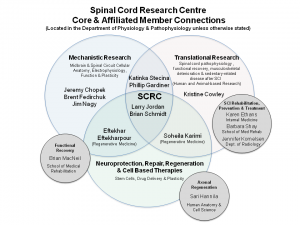SCRC Research Objectives
The Spinal Cord Research Centre (SCRC) of Winnipeg was established in 1987 to develop a world‐class spinal cord training program within the Department of Physiology at the University of Manitoba, and as a partnership between the University of Manitoba, the Health Sciences Centre Research Foundation (now Health Sciences Centre Foundation) and the Canadian Paraplegic Association, Manitoba. The SCRC was reviewed and approved by the Faculty of Medicine Research Committee, and its formation was announced on the occasion of Rick Hansen’s stop in Winnipeg on January 21, 1987 during his Man in Motion World Tour to raise funds for spinal cord research. The SCRC was given formal status as a research centre in the Faculty of Medicine in 2003 by the University of Manitoba Board of Governors.
OBJECTIVES
We are recognized as leaders in the field of locomotor control from membrane properties to systems physiology and neuronal networks and regeneration. We believe strongly that the restoration of function following injury requires a deep understanding of the function and organization of the uninjured spinal cord motor system. Therefore, it is of critical importance to continue with the SCRC’s original mechanistic research as it is the renowned strength of the SCRC. The SCRC’s research objectives will not deviate from the mechanistic research, but will expand its research focus and operate with an integrated research and training strategy with three overlapping ‘thrusts’, specifically:
(1) Mechanistic Research, (2) Translational Research, and (3) Neuroprotection, Repair, Regeneration, and Cell Based Therapies,
essentially as presented in the diagram below.
This integrated research and training strategy is supported through partnership and extensive interaction between the SCRC core members and the affiliates from
Human Anatomy & Cell Science, Internal Medicine (Neurology), Kinesiology, Medical Rehabilitation, and Radiology,
in areas of tissue repair, rehabilitation, prevention and treatment, as presented in the diagram below.
Research ‘thrusts’ objectives:
1. Mechanistic Research
A. Develop a comprehensive understanding of the morphological classes of electrical synapses that exist in mammalian brain and spinal cord, the neural systems and circuitry in which these occur, and the essential functions those synapses confer to neuronal network properties. This will be complemented by the elucidation of the accessory protein composition and macromolecular organization of electrical synapses, and delineation of mechanisms underlying regulation of electrical synaptic transmission. (Dr. Nagy)
B. Investigate the modulatory actions facilitating activation of spinal motor circuitry during motor activity, and how this might be utilized to enhance residual motor function after spinal cord injury (Drs. Chopek, Fedirchuk, Jordan).
C. Investigate mechanisms of locomotor network activation as a feasible target for repair after injury, and as a target for therapeutic (pharmacological and electrical stimulation) intervention (Drs. Cowley, Eftekharpour, Karimi, Schmidt, Stecina).
2. Translational Research
A. Develop a clinical SCI‐specific exercise based research and health delivery capacity in Winnipeg, and identify effective SCI‐specific exercise strategies to reduce development of sedentary‐related diseases. Initial research aims will focus on the use of a currently unavailable form of ‘hybrid’ exercise training that combines voluntary activation of the arms with electrical stimulation to activate paralyzed leg muscles (Drs. Cowley, Stecina)
B. Develop an animal‐based model to identify effective activity‐based treatments for the currently inevitable musculoskeletal deterioration after spinal cord injury (Drs. Cowley, Gardiner).
C. Develop a clinical SCI‐specific human locomotor and balance based training and research capacity in Winnipeg to identify effective strategies for increasing functional motor and balance capacity after spinal cord injury. Initial research aims will be to augment the intact descending motor pathways originating from supraspinal centres (motor cortex, vestibular nuclei and reticulospinal centres) by the use of peripheral sensory input in order to increase functional recovery below the level of the spinal cord injury (Dr. Stecina).
D. Implement a clinically relevant test battery that consists of functional magnetic resonance imaging (fMRI) combined with electrophysiological testing of sensory‐motor functions. This will be ultimately used for directing humans with spinal cord injury and other diseases influencing spinal neuronal function (e.g. multiple sclerosis) into relevant “progressive” rehabilitation programs (such as those mentioned above in 1 and 3).
3. Neuroprotection, Repair, Regeneration and Cell Based Research and Therapies
A. Implement the use of bioengineering approaches to reduce or repair damage to neural tissue caused by spinal cord injury (Dr. Karimi).
B. Develop the capacity for testing animal‐based research findings in relevant human tissue (Dr. Eftekharpour).
For more information: